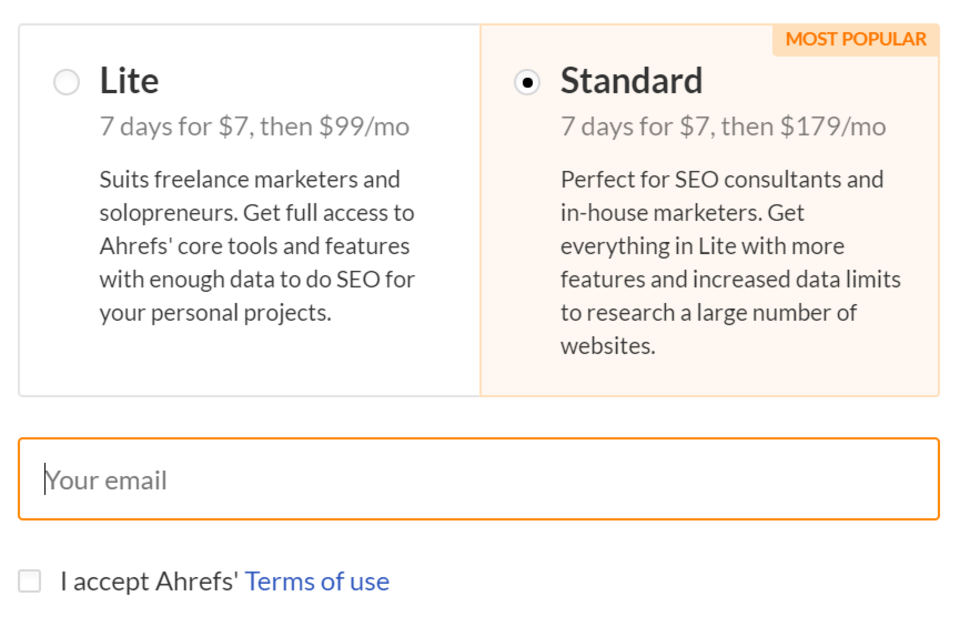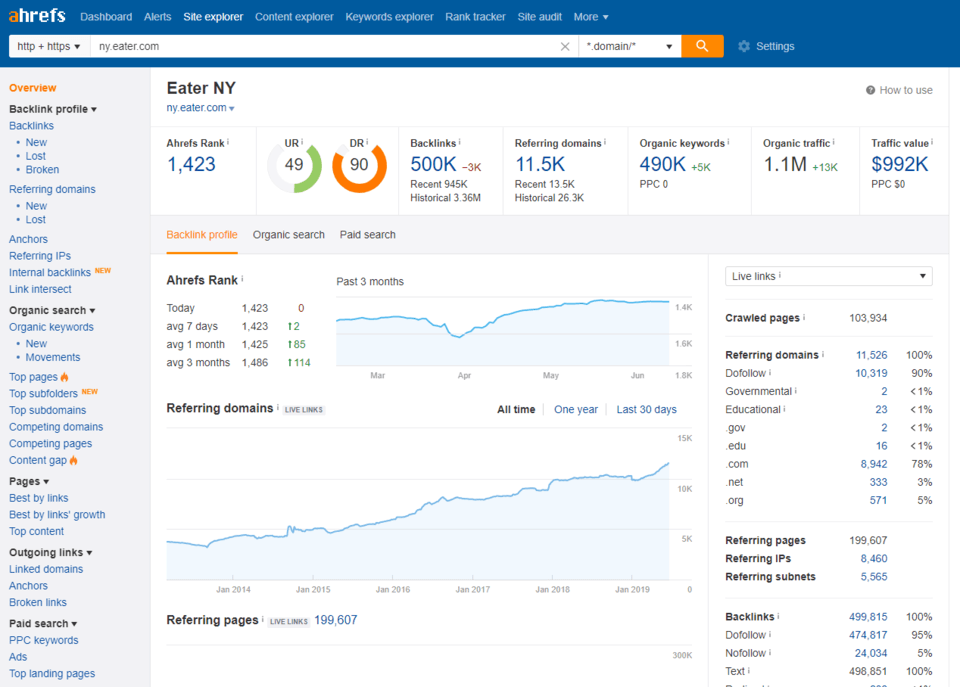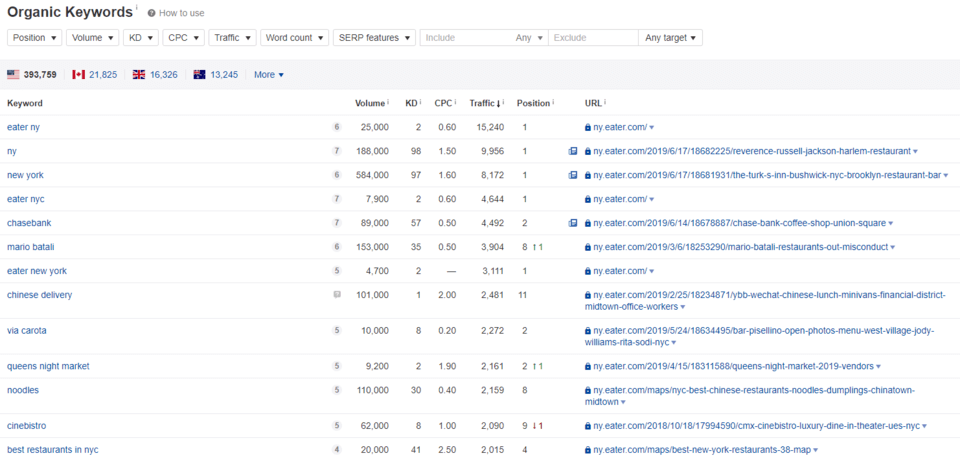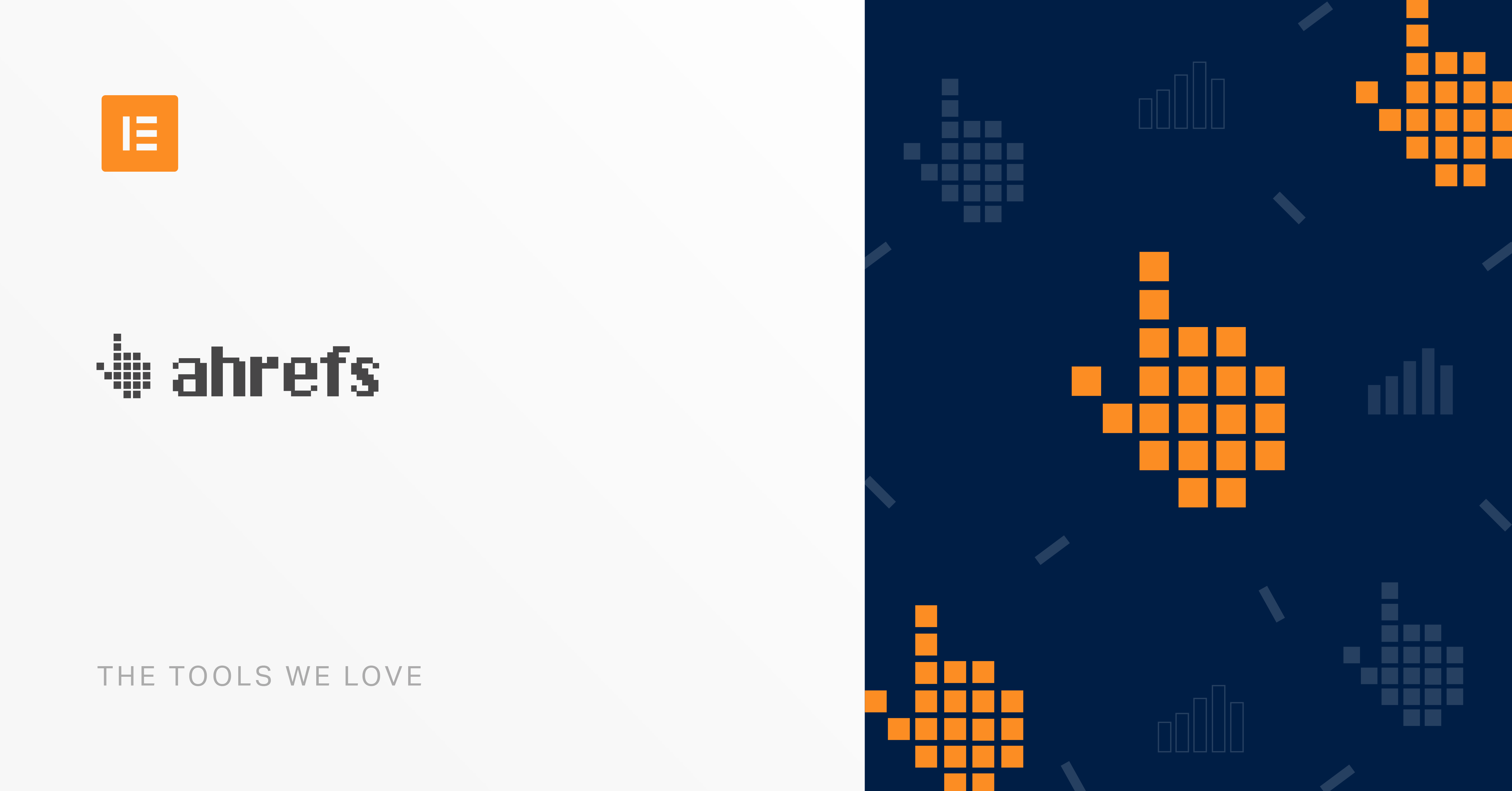As a team of content writers, it is important for us to research every topic we write about. Part of this research involves finding the right keywords, coming up with the best structure for the article we are writing, and looking at other articles which cover the same topic and coming up with better content which would meet our users’ needs and requirements. This part of the research falls under the category of Search Engine Optimisation (SEO).
There are several SEO tools out there that can help you achieve those needs. Ahrefs is one of them and it offers a wide collection of tools that will help you achieve a good SEO analysis. While we, at Elementor, use numerous tools, we especially like Ahrefs and we thought that our community members could benefit from our experience with it.
This is not the first time we cover Ahrefs. Not long ago we had a podcast with Tim Soulo, the head of marketing and product strategy at Ahrefs, where he shared with us methods for promoting products and websites. We are impressed with the tools and the data that Ahrefs provides.
What Is Ahrefs?
Ahrefs is a well-known toolset for backlinks and SEO analysis. Think of it as a swiss army knife, if you will, for your SEO needs. It can replace several tools and is essential for anyone conducting SEO research and analysis. It is one of three main players on the market along with SEMrush and Moz. It offers several tools to help you analyze your website, the market, and your competitors. According to the Ahrefs website, their tool “…helps you learn why your competitors rank so high and what you need to do to outrank them.” With Ahrefs you get competitive analysis, keyword research, backlink research, content research, rank tracking, web monitoring and more.
Here are some of the handy tools that Ahrefs currently offers:
- The Site Explorer tool — With this tool, you can easily analyze your site’s backlinks profile as well as your competitors’ websites.
- The Content Explorer tool — With this tool, you will be able to find the most shared and the most relevant content across social media channels, based on the number of shares.
- The Keywords Explorer tool — With this tool, you’ll be able to get relevant keyword ideas and traffic estimations.
- The Rank Tracker tool — With this tool, you will be able to track rankings and get regular reports.
- The Site Audit tool — This tool will help you analyze your website for common SEO issues and monitor your SEO health over time.
- Alerts will keep you notified of new and lost backlinks, web mentions and keyword rankings.
Ahrefs have their own web crawler which is second only to Google’s behemoth, the GoogleBot. An impressive feat, considering who they are up against.
What Do I Need SEO Analysis Software For?
You need it to stay ahead of your competition and be the best that you can be.
Ahrefs is designed to help you see the overall picture of your rankings, your potential, and what your competitors do. Anyone who is interested in reaching the first pages of search engines has to use an SEO tool like Ahrefs. With all the information laid in front of you, you will be able to make quick and sound decisions regarding your immediate and future strategy.
Get into your users’ mind, see what they are looking for. Find out what words and phrases they use and implement them in your content.
Find out what your competitors do. See who links to their webpages and try to achieve the same. Look at the strongest pages your competitors have and see where your pages fall behind.
Getting Started
Ahrefs is not free. You can try it for the symbolic price of $7 for a 7-day access. Sure, this is not the standard approach to giving out trials, but, we believe that you should try it.

We would like to share our approach with you.
Let’s say that you were tasked with writing reviews about restaurants, specifically Chinese restaurants in New York. You want to create a review of several Chinese restaurants and you want your information to compete with the top search results. Let’s see what a quick Google search will yield when we write the following search query: “Chinese food new york”.

Step 1 — Understanding What Keywords You Need to Use
For starters, we need to understand what keywords to use. We have a general idea, like: “Chinese food new york”. This is a good start. Let’s input this sentence into the Keywords Explorer tool.

We can see that for the phrase: “New York Chinese food”, there are approximately 450 searches per month, which means that this is something that must be included in our article, in titles and content as users tend to search for this specific phrase.
We can also see that the phrase: “best Chinese food in New York” has about 250 searches per month. This gives us the idea that perhaps it’s best to add the word “best” and mention it together with “Chinese food in new york” several times since that’s what people are looking for.
However, the next phrase: “New York style Chinese food” seems a little out of place. We are not writing about the specific cuisine style, but about the different restaurants serving Chinese food in New York. In this case, this specific keywords suggestion does not suit us. By adding different keyword variations in the keyword explorer we will get more suggestions. Suggestions that may be relevant to us, and some that may not.
You can then create a list of words and phrases that must be included in your article and when writing the article, be sure to add them.
In the results, we can find more information like “questions”, “search suggestions” and more. With these options, you can further learn how to construct your page, what headings to use, what additional paragraphs to add, etc.
Step 2 — Analyzing Pages
The next step in our SEO research procedure involves using the site explorer tool. First, we’d recommend that you type in your website’s URL, to see how it ranks. You could see your domain and URL rating, backlinks to your website, organic keywords, your top pages, etc. This is a good routine, especially if you take notes and see how you’ve improved, or worsened over time.
Now, let’s find a well-ranked competitor. From the google search query above, we see that when it comes to organic traffic, https://ny.eater.com is by far the more successful website. Let’s analyze it. Type the URL into the site explorer tool.

Oh boy, there is so much information here, one may get lost. Let us break this information down to its most important elements, as we see it here at Elementor (semi-pun intended):
Site Explorer: The Overview Screen
Our search query has yielded an overview of the most relevant information. This is extremely useful and comfortable. Immediately, we see that the domain rank is very strong, 90/100. To give you an indication of its strength, google.com has 98, and wikipedia.org has 92. However, its URL ranking is mediocre. There are many aspects which affect these rankings, this, however, is a story for another time.
We can see that there are 500,000 backlinks to this website, meaning that there are many other websites who link to this website and use the information available on it as a source to rely upon.
Under the organic keywords column, you can see the number of organic keywords that this website has. Remember the search query “Chinese food new york”, well, this website has covered over 490,000 similarly relevant keywords in its content. You can learn about each of the sections by hovering over the grey ‘i’ beside the section titles.
Site Explorer: The Backlinks Screen
Let’s move on to the backlinks section which provides data about the websites linking to your website. To be more specific, this shows you what external page links to a specific page on your website. Let’s have a look.

You can sort the results by different values, which in this case is the URL strength. A quick glance at the results lets us know that the top linking page (again, in terms of URL strength) is the https://en.wikipedia.org/wiki/Poutine page, which links to the https://ny.eater.com/2017/9/6/16259134/best-poutine-nyc article, about poutine. Clearly, someone at Wikipedia decided that the article at ny.eater about poutine was worth linking to.
It is important to have backlinks from respected websites and institutions, it lets search engines know that other people trust what you write. If you want to succeed, you should start initiating communications with different websites asking them to include an organic link to your content.
Site Explorer: The Organic Search Screen
Next, you should be looking at the organic search results. Here you can see what organic keywords are used by the website and which ones generate the most traffic.

This one is a little tricky. You can’t compete over the keyword “ny”. This is something that is so general, that nearly any page that talks about New York in any way has this keyword. However, this area can give you, along with the keywords explorer tool, an idea as to what keywords to use. In this specific case, we can see the “best restaurants in nyc” keyword. If we didn’t include it before, when we were conducting the keywords search, then we certainly should.
Under “Organic Search”, you can also find results for “Top Pages”. Why not look at the top pages this site has to offer? Look at the structure, at the titles, at what’s being offered. If you are lacking something, try adding it to your page. Additionally, you can see “Competing Domains” and “Competing Pages”, get a better understanding of what the competition is like, work towards creating better content, or, at the very least, nothing worse.
The rest is up to you. There is a lot of information which could be extremely beneficial to you when researching any other topic — be it information, products and services, hi-tech, fashion or anything else you can think of.
This is what the general SEO research process looks like to us. We are certain that there are numerous other ways, approaches and thoughts, but this is how we do it, and this is why we recommend this tool.
What We Like About Ahrefs (The Pros)
AhrefsBot
We like the fact that this toolset has its own, very impressive, crawler bot known as AhrefsBot. Every 24 hours the crawler visits over 6 billion web pages and updates Ahref’s index every 15-30 minutes. With a base of more than 16 trillion known links, we believe that the information provided by Ahrefs is highly relevant, informative and accurate. This crawler is the second most active crawler after Googlebot. In a constantly changing and a highly competitive market, this is something to be proud of.
Simplicity
While Ahrefs is a very powerful toolset, using it is very easy. The user interface is straightforward and very intuitive. You can easily access all the tools. It doesn’t matter if you are a novice or a pro, you will be able to easily use it with just a few clicks.
Availability
We like the availability of information. Once you use one of the tools, you get most of the relevant information on one page. There is no need to dig deeper to find the information you require.
Inspiration
Ahrefs is great when it comes to giving you new ideas. Take the keyword explorer, for example, we typed a simple string of words and got lots of related suggestions which we can further use to improve our content.
What’s Making Us Reconsider Using Ahrefs (The Cons)
Too Expensive
While Ahrefs’ prices are similar to its competitors’, we can appreciate the fact that if you are a freelancer or a small business the price could be a little too steep. There are many free tools available out there, and while they don’t have many of the features Ahrefs does, they could provide a good starting point for your SEO research. Here are some such tools: Keywords Everywhere and Keyword Tool.
Limitations
Despite the high prices for the different plans, there is still a limitation on many aspects like the number of URLs you can search per day, export limitations, keywords list limitations and more. We believe that for certain payment plans there should be no limitations.
Too Much Information
Ahrefs offers a lot of information. Really, a lot. To a professional, this may be great, but to a novice, this information could be overwhelming and not unlike attempting to find a polar bear in a snowstorm.
Bottom Line
Despite having complex algorithms, Ahrefs is simple to use and makes information easily available. Sure it has an unusual approach to giving out paid trials and isn’t cheap in general, but it’s worth it. Anyone aiming at competing with others over good ranks on the search engines has to use this tool. We chose Ahrefs because of its informative statistics which are backed, amongst other things, by a crawler bot, second only to Google.
Function: An SEO research and analysis tool.
Alternatives: There are several alternatives to Ahrefs, with varying prices for different packs, chief amongst are SEMrush and Moz.
Pricing: No free trial. A 7-day trial will cost you $7.
The Lite version costs $99/mo and the Standard version costs $179/mo. There are two more plans for larger enterprises.
You can get the Advanced plan for $399/mo and the Agency plan for $999/mo.
Looking for fresh content?
By entering your email, you agree to receive Elementor emails, including marketing emails,
and agree to our Terms & Conditions and Privacy Policy.
